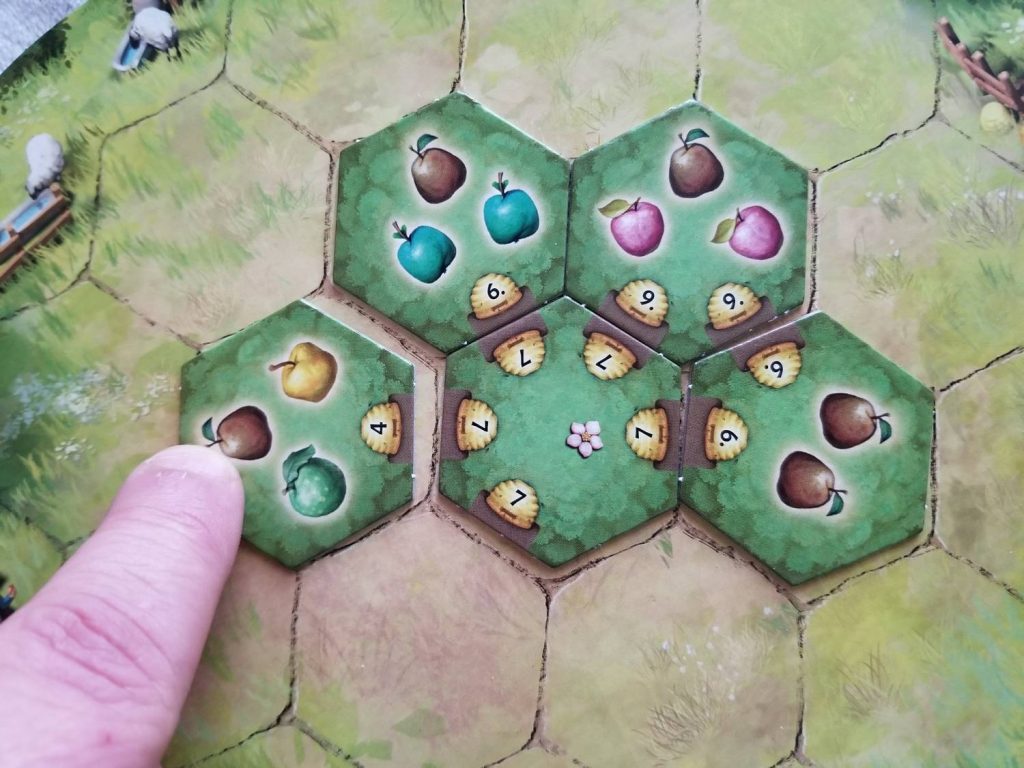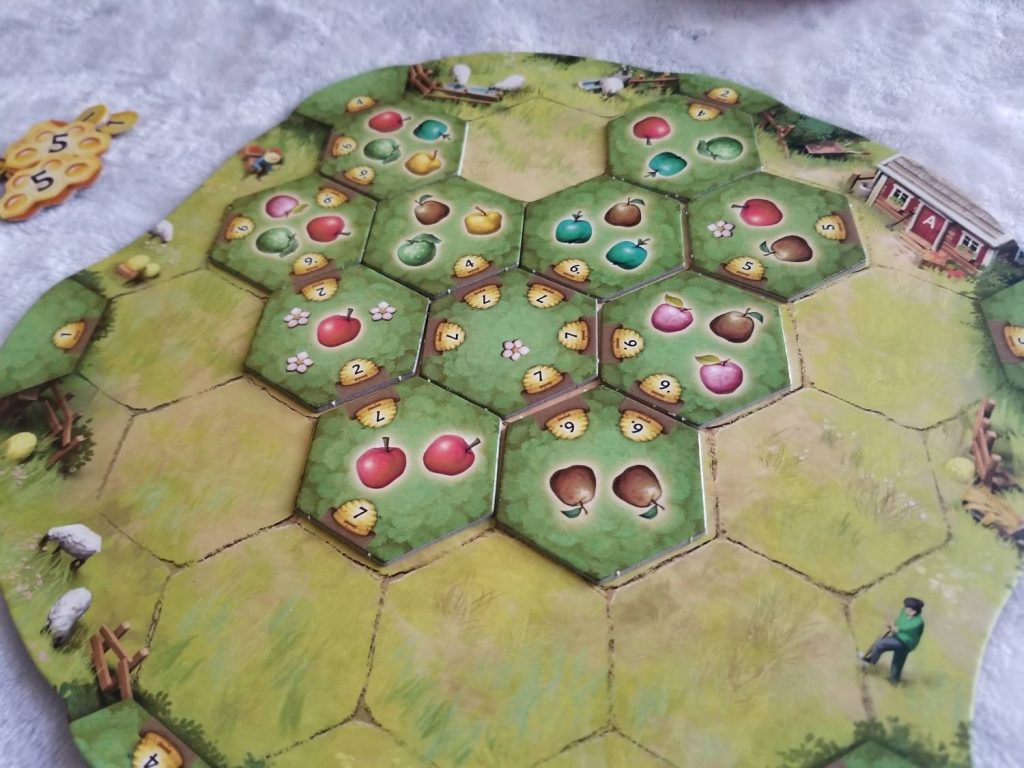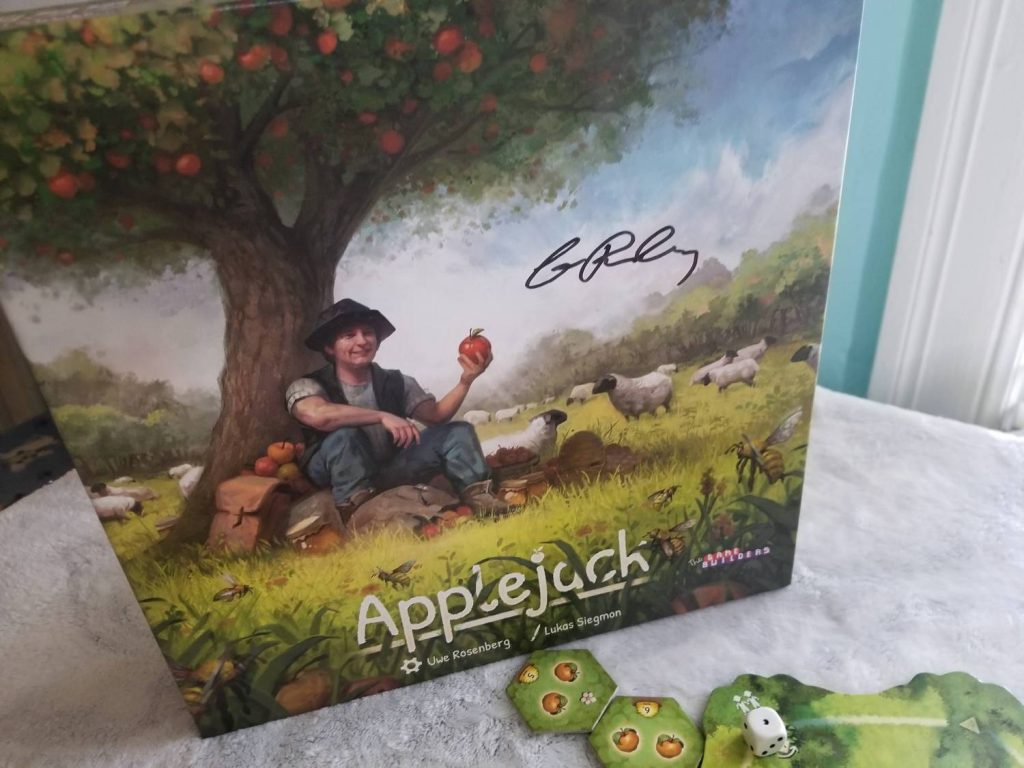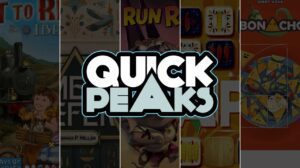July 26th, 2022 marks the day that Applejack first came onto the scene. That’s the day it slipped into the BoardGameGeek database, largely unnoticed but by the obsessive few. When you eat, drink, and dream about Uwe Rosenberg, the daily database check becomes part of your regular routine.
What was this game? Where did it come from?
On July 26th, the BGG entry was little more than a stub, a placeholder for things to come. August came and went and very little had changed, but at least we had a photo of the box top and bottom by the end of it. On September 24th, a rulebook appeared. And just four days later, an exciting announcement, Applejack was going to be on sale at Essen! I wasted no time cajoling fellow writer Justin Bell into picking up a copy of it—and a few other games—for me during his visit.
And now it’s here. It’s hit the table. And I’m excited to share it with you.
Overview
Applejack follows the exploits of the titular Applejack who pulls double duty as both a farmer and a father. Whether this on-the-nose moniker was bestowed upon him by his parents at birth or acquired due to his particular obsession is unclear. But what isn’t unclear is that this guy loves apples and the growing and tending thereof. He, along with his daughter, live in a small cottage on the edge of their orchard where they spend their days enjoying each other’s company and the rewards that come from an honest day’s work… which is presumably an endless supply of apple juice, candy apples, and other such apple-based delicacies.
Applejack is a tile-laying game, the very first Uwe Rosenberg to feature hexagonal tiles as a matter of fact. The game revolves around the central Harvest board (in a very literal sense). Along the edges of the board are groupings of randomly drawn Tree tiles. The central area of the board features a path that is dotted with small icons, which represent the specific players. During each turn, the Applejack die will move from point to point and the player whose turn it is will select one of the Tree tiles that lie along their particular position on the path. Then this tile is added to that player’s personal Orchard board.
The Orchard board is divided into 19 hexagons (just like the setup for a game of Catan). The acquired tile is placed into one of these spots in order to collect honey (which is used to purchase tiles and also worth points at the end of the game) and to create groupings of like apples which have the potential to score end game points. There are additional points to be earned each time the Applejack die makes a full rotation of the board as well. After 19 rounds, the game comes to an end and the player who has earned the most points wins.
Of course, this is a very high-level overview of the game. If you’d like more specifics about how the game works, then keep reading. Otherwise, feel free to skip ahead to the Thoughts section.
Setup
A game of Applejack is set up thusly:

First, the Harvest board for the current player count is placed between the players. Then, the Tree tiles are arranged in a face down pile, shuffled, and two tiles are dealt to each ‘trough’ (the space between the illustrated hedge rows). The Applejack die is set to its 1 face and placed onto the starting position. The extra Tree tiles are kept close by (face down) in a supply along with the Honey tiles.
Now, each player receives an Orchard board and the players collectively decide a side to play with. The A-side is for the standard game (all the boards match) while the B-side is meant for more experienced players (all boards vary slightly). Each player will also start the game with some honey, based on their position in turn order. Determine that by some means, issue the players their honey, and you’re ready to begin.
On Your Turn
On your turn, you will examine the troughs to the left and right of where the Applejack die currently sits. When examining the troughs, if there is only a single tile to choose from, a replenishment is triggered. Beginning with the trough in front of the Applejack die, a single tile is added to each trough from the supply.
Then, you have the option of selecting one of the tiles available in the troughs to the left or right of the Applejack die (or a random one from the supply) and placing it face up onto your Orchard board, in a space of your choosing, after paying its honey cost. Alternatively, you can opt not to pay and place the tile with its sheep side up onto your Orchard board and receive two honey from the supply instead.
This tile placement may earn you some honey. If so, collect it and then move the Applejack die to the next position on the track, without changing its value. If this movement should cause the die to move over the image of an apple, a harvest will be triggered. If this movement causes the die to move over the bridge and back to its starting location, a blossom scoring will occur.
Let’s double back and talk about a few aspects of the game that I mentioned: earning honey, harvests, and blossom scoring.
Honey, Harvests, and Blossoms
Each Tree tile contains several pieces of information: at least one beehive with a number printed inside of it, as well as some number of apples and/or blossoms (including zero of either). The number printed inside of the beehive(s) is the tile’s honey cost, paid when purchasing the tile from one of the troughs. When placing the tile into your Orchard, if the beehive touches a beehive on a different tile (or one of the beehives printed on the Orchard board), then you will gain honey equal to the lesser amount. If multiple beehives should touch, you’ll earn honey from each pairing.

The main goal of Applejack is to build up large ‘areas’ of same colored apples. Each set of connected tiles that contain the image of the same type of apple (of which there are seven) is considered to be an ‘area’. Some areas may consist of just a single tile. This concept comes into play during end-of-game scoring and is also important during the game’s many harvests.
As the Applejack die moves along the Harvest path, it will occasionally cross over the images of different apples. Whenever this happens, a harvest is triggered. The players count up the total sizes of each area on their Orchard board matching this apple, subtract the current value of the Applejack die from each area size, and then collect the remainder in honey.
So, if the Applejack die is currently set to 1 and you’re performing a harvest for the red apple, you would count up your areas for the red apples. Imagine you have two red apple areas, one size five and another size two. You would collect a total of five honey: (5-1) + (2-1).

Lastly, we come to the blossom scoring. When the Applejack die reaches the end of the path, it will return to the beginning of the path by crossing over the bridge. When this happens, a blossom scoring is triggered. Each player counts up all the blossoms in their Orchards, multiplies this total by the value on the Applejack die, and earns honey equal to that amount. Then the value of the Applejack die is increased by one and a new journey along the path begins.
End Game
The game ends once each player has added the final tile to their Orchard board. When this occurs, a final scoring is performed. First, a pseudo-harvest is performed for each of the seven different apple types. This is done in the same way as a regular harvest with this exception: no honey is earned. Instead, the total that would be earned is noted on the score pad. Then the total of all these harvests is added up and multiplied by two and this total is noted.

Bonuses are earned based on how many unique apple types the player earned honey for during the previous steps. Then, this bonus total is added to the doubled total from the harvests along with the value of the player’s leftover honey to determine their final score. The player with the highest score wins.
Thoughts
Idyllic.
Such a calm, soothing word. It’s a word that speaks of picturesque tranquility. The mere thought of the word brings to mind the feeling of walking through a field of flowers, your hands lightly brushing the petals as you pass by, causing the occasional butterfly to erupt into the air, startled from its leafy perch.
It’s a useful word, especially within the confines of this review. From Lukas Siegmon’s gorgeous illustration of Applejack himself sitting beneath a tree, apple in hand, amidst a flock of sheep, to the placid, laid back nature of the game play, Applejack embodies the word and all of its nuances. Idyllicism oozes from every pore.

Uwe Rosenberg wears many hats. There’s the Uwe Rosenberg who designs games featuring tense, in-your-face action such as Babel or Patchwork. Then there’s the Uwe Rosenberg who creates giant, sprawling brain burners such as Agricola or A Feast For Odin. Or there’s the Uwe Rosenberg that surprises you with clever silliness like Bohnanza or Bargain Hunter. Applejack shows us a Rosenberg with a softer side, but there’s no denying Uwe’s fingerprints are all over it.
Applejack is the type of game that you confidently stride into before falling flat on your face. On the surface, it seems so easy. Take a tile, place a tile. The artwork doesn’t betray a sense of ease, either. It’s so vibrant and friendly that you are easily lured into a sense of complacency. It isn’t until you’re in the thick of it that you realize just how clever a game it is that you’re playing.
The tough decision of which tile to select on your turn and then deciding where to place it into your Orchard is obvious. But there are subtleties that begin to emerge that you won’t see coming. Consider your voyage around the path on the Harvest board. Eventually you’re going to find yourself in a situation where you have exactly two choices: the tile in front of you or the tile behind you. Taking the tile in front of you that’s really good for you is going to trigger a replenishment. Taking the tile behind you that’s not so great isn’t. A replenishment isn’t going to help you any. It’s only going to help your opponents by giving them more options. So, should you or shouldn’t you?
And then there’s the end game to consider. Since each area for the apple types is going to have 3 subtracted from it automatically (as the Applejack die will be turned to 3 at that point), in order to score for any of the types, your smallest area will have to consist of no less than four apples. That’s much easier said than done. Do you try and set yourself up for harvests mid-game or do you focus your efforts on a large end game payout? Or do you try to find a middle ground? Or maybe you ignore the apples entirely and laser focus on collecting blossoms? There’s no easy solution. Applejack is an emergent puzzle that takes a few plays to wrap your brain around.
Speaking of blossoms, that brings me to one of my negative sticking points. Now, I will admit that I am no expert at this game. In fact, I have never won a single play of it over the ten or so times I’ve played. But it does seem like the person that scores the highest during the blossom scorings wins almost every single time. This disproportionate balance that favors blossoms over apples just seems counter to the spirit of the game, in my opinion. Applejack should be a game that heavily favors those who do best with their apples. I mean, the word ‘apple’ is right there in the name.
My only other negatives are component issues, more minor inconveniences than anything. Firstly, I’ve mentioned it in previous reviews, but it really gets my goat when a game should come with a drawstring bag but doesn’t. Applejack has you pouring all the tiles onto the table, flipping them over to their sheep sides, and then shuffling them. It’s so much easier and so much faster to pull them from a bag. I spoke to the publisher about this and, while they had considered adding bags to the games, they ultimately decided against it due to the cost. That’s fair, I guess. But you can’t stop a gamer from dreaming.
Secondly, in my copy of the game, there’s a slight warp to the Harvest boards. This bowing causes the boards to spin in place unless I make an effort to flatten them. It can be obnoxious having to reset the position of the Tree tiles each time the board spins and moves them along with it.
Lastly, my version of the game came with German rules only, which I expected might be the case when I begged Justin to bring me back a copy from Essen. Fortunately, The Game Builders have uploaded an English rulebook to BoardGameGeek. Unfortunately, the formatting of that rulebook is so weird that there’s no way to print it off on a standard home printer without losing some of the text on the edges, unless it’s printed really, really small. Lucky for you, though, this bothered me so much that I enlisted the help of my fellow Meeple Mountaineers to rework it into a more printer friendly format which I’ve uploaded to BGG. You’re welcome.
All in all, there’s a lot more to like than there is to dislike. Applejack is the kind of game you find yourself thinking about long after you’ve finished playing it. Whether it’s the artwork, the gameplay, the strategy, or the pedigree of its designer, there’s just something about this game that keeps me coming back for more.
Maybe next time I’ll actually win.











Add Comment